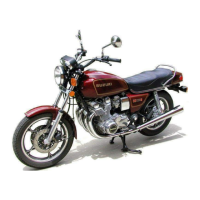
Do you have a question about the Suzuki GS1000G 1980 and is the answer not in the manual?
| Year | 1980 |
|---|---|
| Manufacturer | Suzuki |
| Model | GS1000G |
| Category | Motorcycle |
| Displacement | 997 cc |
| Bore x Stroke | 70.0 mm x 64.8 mm |
| Compression Ratio | 9.2:1 |
| Ignition | Electronic |
| Transmission | 5-speed |
| Final Drive | Shaft |
| Front Suspension | Telescopic forks |
| Front Brakes | Dual disc |
| Rear Brakes | Single disc |
| Front Tire | 3.50-19 |
| Rear Tire | 4.50-17 |
| Engine Type | Four stroke, transverse four cylinder, DOHC |
| Fuel System | Carburetor |
| Rear Suspension | Dual shocks |
| Seat Height | 810 mm |
| Fuel Capacity | 22 liters |
Guidelines for safely selecting and installing accessories on your Suzuki motorcycle.
Importance of wearing a safety helmet and proper eye protection for motorcycle riders.
Advice on choosing quality motorcycle riding apparel for safety and comfort.
Emphasizes performing a thorough safety inspection before riding the motorcycle.
Recommends practicing riding in non-traffic areas to become familiar with controls.
Encourages riding within personal skill boundaries to avoid accidents.
Advises extra caution on wet roads, slippery surfaces, and at crossings.
Mentions a supplementary handbook with riding safety tips.
Details the function of the ignition switch and its positions (OFF, ON, PARK, LOCK).
Explains the four positions of the ignition switch and their operational effects.
Describes the function of each gauge and indicator light on the instrument panel.
Explains the operation of the lights operating switch, horn button, and clutch lever.
Details the engine kill switch, throttle grip, electric starter button, and front brake lever.
Explains the use of the choke knob for starting cold engines.
Instructions on how to open and install the fuel tank cap.
Describes the three positions of the fuelcock (ON, RESERVE, PRIME) and their functions.
Explains how depressing the rear brake pedal applies the brake and activates the brake light.
Details the operation of the 5-speed transmission and gear shifting procedure.
Instructions on how to operate the seat lock to open and close the seat.
Explains how to use the helmet holder located near the seat.
Describes how to use the center stand and side stand for parking the motorcycle.
Recommends unleaded or low-lead gasoline with specific octane ratings.
Advises using premium four-stroke motor oil rated SE under API classification.
Specifies SAE90 hypoid gear oil (GL-5) for the transmission.
Step-by-step guide for starting the engine when cold and warm.
Instructions on how to smoothly engage first gear and start moving the motorcycle.
Explains how to use the transmission gears effectively based on speed and conditions.
Advice for climbing and descending hills, including downshifting for braking.
Guidance on applying brakes, stopping, parking, and securing the motorcycle.
Recommendations for adjusting suspension and tire pressure for high-speed riding.
Information regarding maintenance and repair of emission control systems.
Notes the location of the EPA compliance label on the rear fender.
Lists the tools included in the motorcycle's maintenance tool kit.
Procedures for changing the oil in the secondary gear case.
Details adjustments for carburetor idle RPM.
Guidance on adjusting clutch cable play for optimal engagement and disengagement.
Information on the front and rear disc brakes and scheduled inspection requirements.
Warnings and precautions regarding the handling of brake fluid.
How to inspect front and rear brake pads for wear and when replacement is needed.
Instructions for adjusting the rear brake pedal to prevent brake drag.
Importance of checking tire inflation pressure and tread condition for safety and tire life.
Explains the impact of incorrect tire pressure on stability and wear.
Advises on when to replace front and rear tires based on tread depth.
Provides recommended cold inflation tire pressures for solo and dual riding.
Steps to check and adjust front fork air pressure using a hand pump.
Instructions on how to adjust the spring preload on the rear shock absorbers.
Details how to adjust the damping rate on the rear shock absorbers.
Cautions for tightening axle bolts, caliper levers, and wheel installation.
Further steps for removing the rear wheel axle, shock absorbers, and torque link.
Cautions for installing the rear wheel, caliper, and torque link.
Detailed procedure for replacing the headlight bulb.
Instructions for replacing the tail/brake and license plate light bulbs.
Steps for replacing the turn signal light bulb.
Location and function of the fuse box and output terminal for accessories.
Lists the fuses by amperage and the electrical systems they protect.
Diagnostic steps for an engine that refuses to start, checking fuel and ignition.
Common causes and checks for engine stalling, including fuel and ignition.
Warnings related to fuel spillage and consulting a dealer for issues.
Steps to take when removing the motorcycle from storage and preparing it for use.
Physical dimensions and weight specifications of the motorcycle.
Technical specifications for the engine type, bore, stroke, displacement, etc.
Details on the clutch, transmission type, gear ratios, and reductions.
Specifications for front/rear suspension, steering angle, caster, and trail.
Specifications for front and rear brakes, and tire sizes.
Details on ignition type, timing, spark plug, battery, generator, and fuses.
Specifications for fuel tank, engine oil, fork oil, and gear oil capacities.